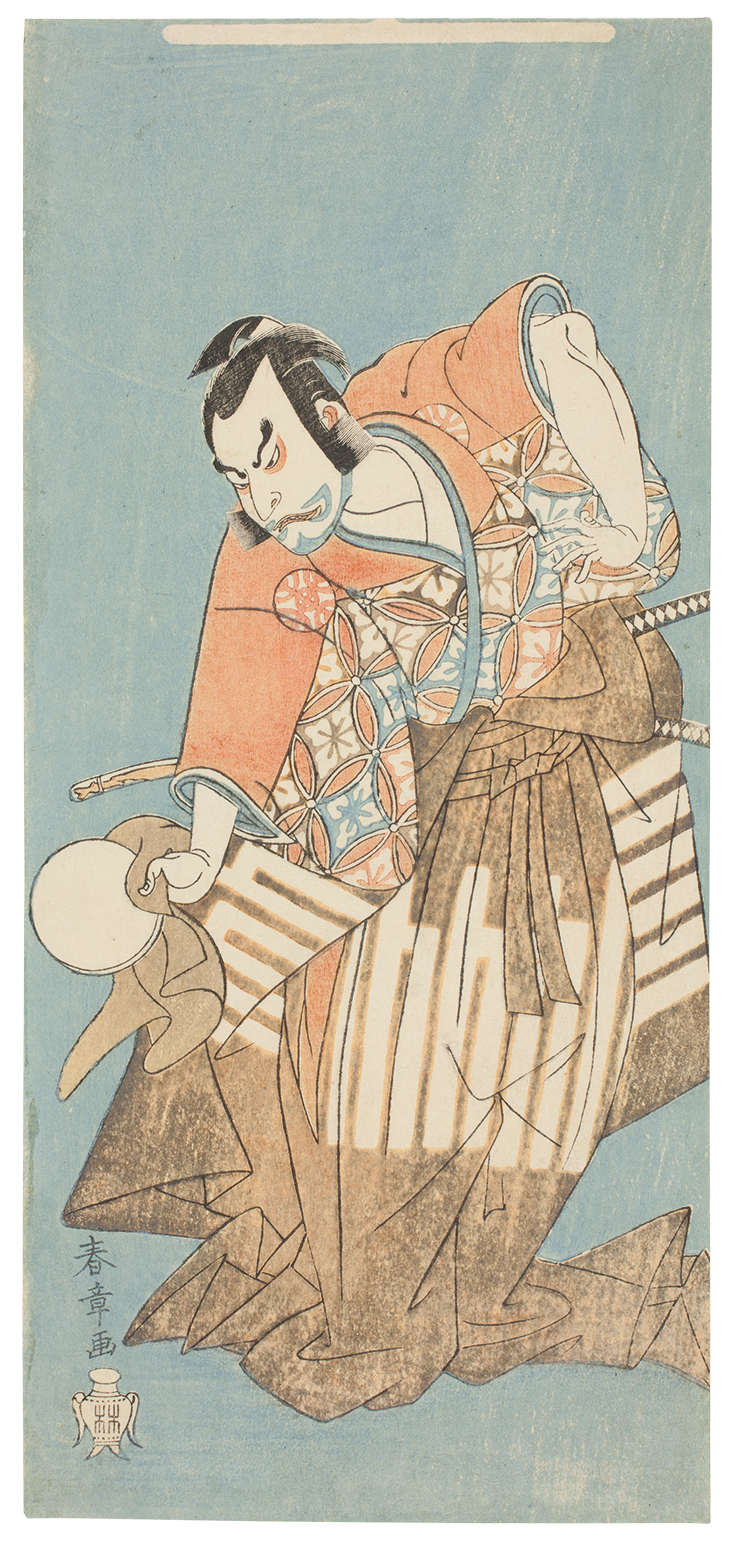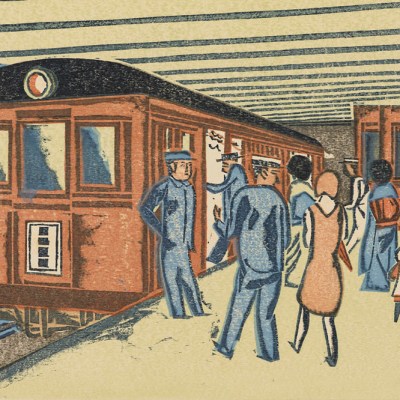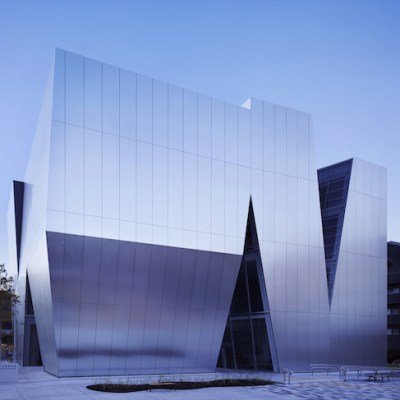From the February 2022 issue of Apollo. Preview and subscribe here.
About 400 years ago, the first sparks of a new art-form could have been seen just five minutes’ walk from where I now sit writing in Kyoto. The date was almost certainly 1603, though it is not clearly recorded. It was probably a blazing summer evening. That year had seen the founding of a shogunate, Japan’s third, under the powerful warlord Tokugawa Ieyasu. With it came the promise of stable peace after a truly monstrous 130 years of civil war, which had devastated the whole country. Indeed, there no longer was a country – this era of the sengoku, or Warring States, had lasted more or less from 1470–1600. The shogun was now building a massive bridge – the Bridge of Japan, or Nihon-bashi – at his castle seat of Edo, symbolising reconnection and the return of authority. Edo is now of course Tokyo, one of the world’s greatest cities, but at the time, these were the Eastern marches. The capital, Miyako (now Kyoto), lay 300 miles to the West.
While Edo had a large central river – today’s Sumida in Tokyo – Miyako had little more than a stream running down its eastern side called Kamo-gawa, or ‘Duck River’; today it is still full of ducks, and also, depending on the season, egrets and cormorants. It once marked the city’s end but its flow was paltry, so easy to ford, and people had long inhabited the far side as well. When peace came, a bridge was erected here too, at the point where the great highway from Edo entered Miyako at Sanjo, or ‘Third Avenue’. For those familiar with London, the situation was similar to Bankside (where Tate Modern is today). That side of the river was a liminal zone, not quite city, not quite country. Sanjo Bridge was new, while London Bridge was old, but in both cities the far banks evaded state control, and were under the charge of independent-minded prelates, who, perhaps contrary to expectations, took a distinctly relaxed view of life. From his palace at Bankside, the Bishop of Winchester turned a blind eye to the riotous drinking and ‘Winchester geese’ (sex workers) on his side of the river; similarly, across Sanjo Bridge, the abbot of the Kennin-ji preferred not to notice that the forecourt of his temple was home to a string of taverns and bordellos.
There was little policing across the Kamo river, but the people of Miyako had another option: the riverbed itself. This was always dry in parts, and devoid of water during some periods, especially in summer. With the arrival of peace, young men were no longer fearful of press-gangs in this area, while families no longer feared letting their daughters wander out. Those who flocked here were called the kawawa-mono (‘river-bankers’). This was not always a term of praise. Cavorting youths were also called kabuki-mono, or ‘benders’. What they did might be fun, but it was not quite upright, as a person ought to be.
One such ‘bender’ was Okuni. She is sometimes referred to as a shrine maiden, and claimed to have served at the great sanctuary to the gods in far-off Izumo. She could not prove this, however; nor was ‘maiden’ the best term for her, by any stretch of the definition. She danced lewdly, twisting and turning, ‘bent’ indeed. She augmented this outrageousness by wearing men’s clothes, complete with longsword, and by sporting a crucifix, presumably obtained from some Portuguese Jesuit. Sanjo-kawara (‘The river bank at Third Avenue’) became Kyoto’s main hub of fun, and still is. A statue of Okuni marks the spot today.
Folding screen with scenes of women’s kabuki (c. 1615), studio of Kano Takanobu. Metropolitan Museum of Art, New York

We don’t know any facts about Okuni, nor what her ‘bent’ dancing – kabuki – looked like. We know that people enjoyed it, and that the style caught on. It was copied all across the country, and the first person to record impressions of this new fad was the manager of the English trading station down on the coast, a man named Richard Cocks. He explained that kabukis (which he spelled caboques) were quite something to see. The Japanese delight in wordplay, and before long kabuki was being written with other characters. A witty neologism, which also better described the performances, had the ka rewritten with the homophonous word for song, while bu was written with the homophone meaning dance and ki was written with the word for, well, sex worker. It summed things up clearly enough.
The shogunal governor in Miyako felt he needed to quieten things down. He was able to assert his authority and banned women from the riverbed’s jerry-rigged stages. (This was the case at the Globe Theatre too, for identical reasons.) However, this did nothing to ameliorate the issue. Boys took on female roles, offering their services to the same clientele. So, in 1629, boys were also banned. The adult actors complained that the boys had to learn their trade when young, so the governor relented, allowing them back on condition that they adopted adult haircuts, which meant shaving off their winsome forelocks. The adults responded by covering this loss with purple headcloths.
Over the next four centuries, kabuki evolved into a highly developed theatrical form, though always rambunctiously dealing with immediate, more vulgar concerns – jealousy, murder, revenge. To this day the female roles are taken by men, though the purple headcloth has been abandoned, and career specialists do not switch when their voices break.
Despite the fact that actors were officially outcasts, the profession was passed on in families, as were stage names. By the mid 17th century, the best male roles were being monopolised by the Ichikawa family, whose most senior member was named Danjuro. He retired in 1704, and the name was allocated to his best successor. (This goes on [see Cover]: Danjuro XII died in 2013, and after a hiatus, Danjuro XIII was finally nominated in 2020, though official succession has been delayed by Covid. He and other actors tread the boards to great acclaim in socially distanced theatres; though it must be said that kabuki is a staid – or, perhaps, rarefied – version of what it once was.) By this point kabuki had long since migrated to Edo, the shogun’s city. Fixed theatres were allowed just by the Bridge of Japan. The location was important. Not only was it prominent, it was also accessible, to all classes and genders, including to those who didn’t see themselves as ‘bent’. The sex-work issue certainly did not go away, but it become more discreet. Vulgar humorists would comment that ‘boy actors roll over at 5pm’, which was the hour when respectable women went home.
Kabuki Actor (c. 1708), attrib. Torii Kiyonobu. Metropolitan Museum of Art, New York

These theatres had advertising boards outside promoting their plays and stars, produced by artists from the studio known as the Torii School. One of the school’s founders, Torii Kiyonobu, had moved to Edo from Osaka (which also had kabuki shows), and at the end of the 17th century he had the idea of producing theatrical ephemera. This consisted largely of what are called yakusha-e, or ‘actor pictures’, which show stars in fixed poses (mie), a feature of kabuki in which actors hold a position for several seconds to emphasise a dramatic moment. In the pictures actors were not shown on stage, but rather the scenes were depicted as though they took place in real life. It was a sensational concept. Probably actors paid for self-promotions, and publishers jumped on the bandwagon to stoke fads. It was surely lucrative, though we lack information on business models.
Actor pictures took on a life of their own, and today collections are dotted around Japan, Europe and North America. One exemplary collection can be found at the Art Institute of Chicago, which is currently staging ‘The Golden Age of Kabuki Prints’ (until 26 June). This exhibition focuses on the work of another studio of actor pictures, the Katsukawa School, which broke away from the Torii in the second half of the 18th century. From 1765 onwards woodblock prints could be made in full colour, and had taken Japan by storm under the label nishiki-e, or ‘brocade pictures’. The Art Institute has some 700 from Katsukawa masters, many from the collection of the financier Clarence Buckingham, whose objects were loaned to the museum on his death in 1913, and later donated. Most of the rest are from the banker-turned-scholar Frederick Gookin, who was the first curator of the Buckingham Collection after it entered the Art Institute, and who died in 1936.
The Actor Nakamura Nakazo I as Osada no Taro in the play ‘Ima o Sakari Suehiro Genji’ (The Genji Clan Now at Its Zenith) (detail; c. 1768), Katsukawa Shunsho. Art Institute of Chicago

Katsukawa Shunsho, who established the school, trained a line of masters. On his death in 1793, a considerable workshop was producing actor prints in his style, as well as one-off paintings. Shunsho’s forte was realism, though the term is relative given the thick kabuki make-up and dramatic poses – in a word, the theatricality – which punters had to be able to see from a distance over a sea of heads. Shunsho also worked in the other main demi-monde genre, delicately called bijin-ga, or ‘pictures of beautiful people’ – courtesans and female sex workers (actors still often doubled as male sex workers). Theatre and bordello were two sides of the floating-world (ukiyo), or urban leisure; one based on the male body, one on the female.
Among Shunsho’s best pupils was Shuncho, who may have been about the same age as his master, as their dates are similar. The era drew to a close with Shun’ei, who lived well into the 19th century. Most Katsukawa masters had shun (‘spring’) in their given name. Another was a certain Shunro, who attained fame after going independent, using the name Hokusai.
Theatre prints tend to show a duo of actors, in the role of lovers, master and servant, lady and maid, and so forth. Names and roles are included on the painting, so comparison with extant documents allows the name of the play to be discovered. Since performance dates are known, if the period of the run can be found the print can be precisely dated. This is never possible with prints of ‘beautiful people’, making it harder to construct the masters’ evolving oeuvres. However, the format can make for leaden titles. Included in this exhibition, for example, is Shunsho’s Sawamura Sojuro in the Role of the Chinese Sage Huangshi Gong with Ishikawa Danzo III in the Role of the Chinese Warrior Zhuang Liang, from the play At Mt Otoko: A Trial of Strength in Drawing the Bow (performed in 1768). Virtually all scripts are lost, so nothing is known of what unfolds in the depicted scene, unless the play derives from a well-known story. Many kabuki works were revisions of puppet dramas, however, for which scripts do survive.
The works on show in Chicago are powerful and in immaculate states of conservation. They vividly show the lineage of the Katsukawa School, why it is particularly admired among actor prints, and also something of the thrill of kabuki to viewers of the time – and, clearly, to viewers of more recent times, too. It’s surely no coincidence that, in another wordplay, the ki of kabuki is today written with a different homophone, meaning ‘skill’.
Half-length portrait of kabuki actor Kawarazaki Gonjuro as Ono no Yorikaze (1863), Utagawa Kunisada. Photo: © Trustees of the British Museum

‘The Golden Age of Kabuki Prints’ runs at the Art Institute of Chicago until 26 June.
From the February 2022 issue of Apollo. Preview and subscribe here.


